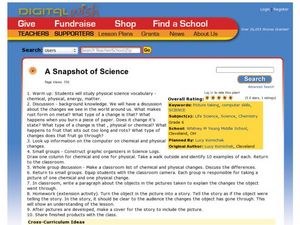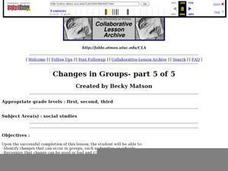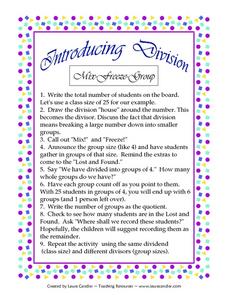Curated OER
The Natural State
Following an examination of the Arkansas state quarter, your class will discuss the state's nickname: "The Natural State." They will focus on its abundance of natural resources. Printables for the activities are included.
Curated OER
Fraction Frenzy
Second graders identify fractions as part of a set. They explain concrete and symbolic representations of whole numbers, fractions, decimals, and percents in real-world situations. They complete a web-based cookie baking lesson.
Curated OER
Peter Rabbit Meets Charles Darwin
Students start to think of evolution in terms of populations. The class follows a cartoon scenario of a rabbit population in which there is selection and change of gene frequency. They receive copies of the scenario or the whole thing...
Curated OER
The Population Explosion: Causes and Consequences
Students use this lesson to focus on population growth and the threat of overpopulation. In groups, they analyze the world birth and death rates to determine the growth rate of the population. As a class, they discuss the causes and...
Curated OER
Express Yourself!
Students practice the strategy of reading fluently with expression with the story "Who took the Cookies from the Cookie Jar?" They read and reread the story utilizing different strategies when stuck on a word. Students practice whole...
Curated OER
Quicksand Questions: Short In-class Activity
Students are prompted with questions during a lecture on quicksand. Student answers can be collected with classroom response systems. The responses (both individual and the class as a whole) are recorded on the instructor's computer....
Curated OER
Archaeology and Storytelling
Young scholars identify and interpret both individual families and whole cultures learn about their pasts by collecting and analyzing stories and artifacts. Then they identify that not all archaeological finds readily reveal their...
Curated OER
MyPyramid for Kids
Students explore healthy food choices. In this science lesson, students identify food groups and discuss the amount of food they should eat from each group. Students create PyramindPal cartoons.
Curated OER
Place Value Lesson
Fourth graders use place value structure to construct and compare numbers that are up to the ten thousands. In this place value lesson plan, 4th graders explain and discuss numbers that are greatest in size according to the place of the...
Curated OER
Mix Freeze Group
Students practice division. For this division lesson plan, students are the numbers for your division problem. You begin with the number of students in the class, have students mix until you call freeze. Announce the group size and...
Curated OER
Famous Rock Groups
Students define igneous, metamorphic, and sedimentary, and use rock identification books to identify igneous, metamorphic, and sedimentary rocks. Students then discuss which rocks early man would have found useful for tool creation.
Curated OER
Count Around
Students explore counting. In this numeration math lesson, students read a question that poses a "counting" question, count the identified classroom objects, and write their answer on a sticky note. Students place their note under the...
Roy Rosenzweig Center for History and New Media
Reward: Valuable Slaves
To gain insight into the American institution of slavery and how African Americans were viewed during this time, groups examine run-away slave ads and slave auction broadsides. Teams use the provided worksheet to record their impressions...
Science Matters
Island Fox Outreach
Off the coast of California lives a wild animal called the Island Fox. Experts discuss the importance of the Island Fox to the Channel Islands and the balance the fox creates within its ecosystem. The lesson concludes with a reading of...
Curated OER
Hispanic World - Spain
Take your class on an electronic field trip to Spain! Visit Cordoba or Barcelona, and run with the bulls (virtually) in Pamplona. Groups search the Internet to find sites that permit them to explore the original Spanish-speaking country....
Mathematics Vision Project
Module 1: Getting Ready Module
This fabulous resource is a must-have for any algebra teacher's arsenal of lessons. Developing the idea of equations and use of variables from basic physical scenarios, learners gain valuable intuition in the structure and meaning of...
Curated OER
A Snapshot of Science
Sixth graders explore physical and chemical changes. In this physical science lesson, 6th graders study vocabulary, discuss the changes they see in the world and look up information on chemical and physical changes. Students create...
Curated OER
Conventions - Punctuation Research
Study unusual punctuation marks in this punctuation lesson. Young grammarians work in small groups to research one of the unusual punctuation marks (semi-colon, colon, dash, comma, ellipses, or quotation marks) and discuss how the mark...
Curated OER
Finding Equal Groups
Build counting fluency in your kindergartners with this counting and grouping timed learning game. Provide various groups of objects to count such as a clear plastic bag filled with 7 beans or a cup with 5 pennies. There are many other...
Curated OER
Family Quilts Keep us Warm
Students explore families and culture. For this family and culture lesson, students discuss their families and their similarities and differences. Students read the book The Keeping Quilt by Patricia Polacco and create their own quilt...
Curated OER
Changes in Groups
Learners identify changes that can occur in groups and recognize whether change can be good or bad.
Curated OER
The Importance of Groups
Students discuss why groups are important and why humans go through daily life performing group activities.
Curated OER
Mix Freeze Group
In this mathematics worksheet, students write the total number of students written on the board. Then they draw a division house around that number and discuss breaking the number down into groups.
Curated OER
What Are The Odds?
Students read the book, Jim Ugly, and discuss whether the odds were in favor of or against the character Jake finding his dad. They demonstrate an experiment involving odds by keeping a tally of how many times a colored die is pulled out...

























